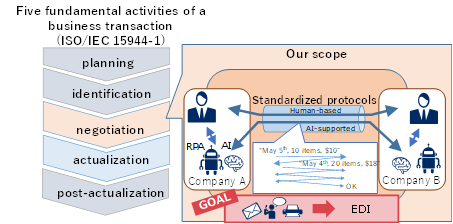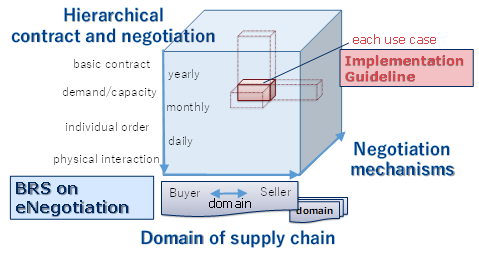E Negotiation
other Linktoparent
Project Details
| Page properties | |||||||||||||||||||||||||||||||||||||||||||||||||||||||||||||||||||||||||||||||||||||||||||||||||||||||||||||
|---|---|---|---|---|---|---|---|---|---|---|---|---|---|---|---|---|---|---|---|---|---|---|---|---|---|---|---|---|---|---|---|---|---|---|---|---|---|---|---|---|---|---|---|---|---|---|---|---|---|---|---|---|---|---|---|---|---|---|---|---|---|---|---|---|---|---|---|---|---|---|---|---|---|---|---|---|---|---|---|---|---|---|---|---|---|---|---|---|---|---|---|---|---|---|---|---|---|---|---|---|---|---|---|---|---|---|---|---|---|
|
Project Purpose
| Text Area | ||||
|---|---|---|---|---|
| ||||
Prior to the exchange of purchase order information during the BSP “BUY” phase, human staff in both companies negotiate the transaction conditions via email or telephone. However, this is changing with advances in digital transformation and artificial intelligence; Therefore, the semantics of negotiation process and exchanged information should be standardized. The negotiation process is entering a digital transformation (DX) where both buyer and seller have developed electronic systems. From the buyer side, the system often allows them to develop their own electronic bidding system and bid comparison system. From the seller side, a sales system has to connect to multiple prospective buyer systems, each with different semantics. Standardized semantics would allow the seller to not only reduce cost, but also to set up a decision making system defining which item(s) should be sold to which company(ies). In addition to this digital transformation, artificial intelligence (AI) and robot process automation (RPA) can ultimately assist in achieving better negotiating conditions. Current human-based negotiations require a human decision at each proposal; therefore, message exchange can increase exponentially in order to reach the best solution among possible conditions of the contract. With an AI negotiator, the exchange can be automated allowing to reach better condition faster. The final approval may still require human approval, but this approach achieves business efficiency and optimality. ISO/IEC 15944-1 defines five fundamental activities (repeated in the UN/CEFACT UMM User Guide of 2003) of a business transaction: planning, identification, negotiation, actualization and post-actualization. This work corresponds to the negotiation phase. |
Fig. 1: Concept of EDI-based negotiation.
Project Scope
| Text Area | ||||
|---|---|---|---|---|
| ||||
This project aims to define the business processes and related data exchange requirements related to electronic contract negotiations. This will concentrate specifically on protocols and data formats rather than internal decision processes. In this way, a human negotiator, an AI negotiator, or a human negotiator assisted by an AI/robot support should use the same base semantic protocols. Three use cases will be considered, one in manufacturing, one in marine and the other in air cargo. The focus will be on the conditions of the contract between the two parties. The existing BRS and related standards for eTendering and CI-Scheduling will be used as a point of reference. This project will consist of three axes: • Hierarchical contract - what aspect of business relationship is being established: yearly contract (basic contract), monthly (on-demand/capacity), daily (by a due date) • Supply Chain – the relationship between buyer and seller for each domain • Negotiation – The negotiation mechanism contains a variety of rules; nested negotiation, competitive negotiation, asynchronous/synchronous negotiation and so on. |
Fig. 2: Negotiation Framework
Project Deliverables
| Text Area | ||||
|---|---|---|---|---|
| ||||
The project deliverables are: Deliverable 1: BRS on eNegotiation Deliverable 2: CCBDA message structures for eNegotiation Deliverable 3: Relevant alignment into the CCL based on SCRDM for eNegotiation Deliverable 4: Implementation Guideline |
Exit Criteria
| Text Area | ||||
|---|---|---|---|---|
| ||||
The exit criteria will be: Exit Criteria for Deliv. 1: BRS ready for publication (External Review Log showing that all comments during Public Review have been addressed) Exit Criteria for Deliv. 2: CCBDA message structures ready for publication Exit Criteria for Deliv. 3: CCL alignment completed and ready for release Exit Criteria for Deliv. 4: Implementation Guide ready for publication |
Project Team Membership and Required Functional Expertise
| Text Area | ||||
|---|---|---|---|---|
| ||||
Membership is open to UN/CEFACT experts with broad knowledge in the area of: Contract negotiation, artificial intelligence, computer-assisted decision-making, procurement In addition, Heads of Delegations may invite technical experts from their constituency to participate in the work. Experts are expected to contribute to the work based solely on their expertise and to comply with the UN/CEFACT Code of Conduct and Ethics and the policy on Intellectual Property Rights. |
Geographical Focus
| Text Area | ||||
|---|---|---|---|---|
| ||||
The geographical focus of the project is global. |
Initial Contributions
| Text Area | ||||
|---|---|---|---|---|
| ||||
• UN/CEFACT eTendering BRS version 2.8, 2007 • UN/CEFACT Cross-Industry Scheduling BRS version 2, 2017 |
Resource Requirements
| Text Area | ||||
|---|---|---|---|---|
| ||||
Participants in the project shall provide resources for their own participation. The existence and functioning of the project shall not require any additional resources from the UNECE secretariat. |
Project Proposal Files
| Attachments | ||
|---|---|---|
|



